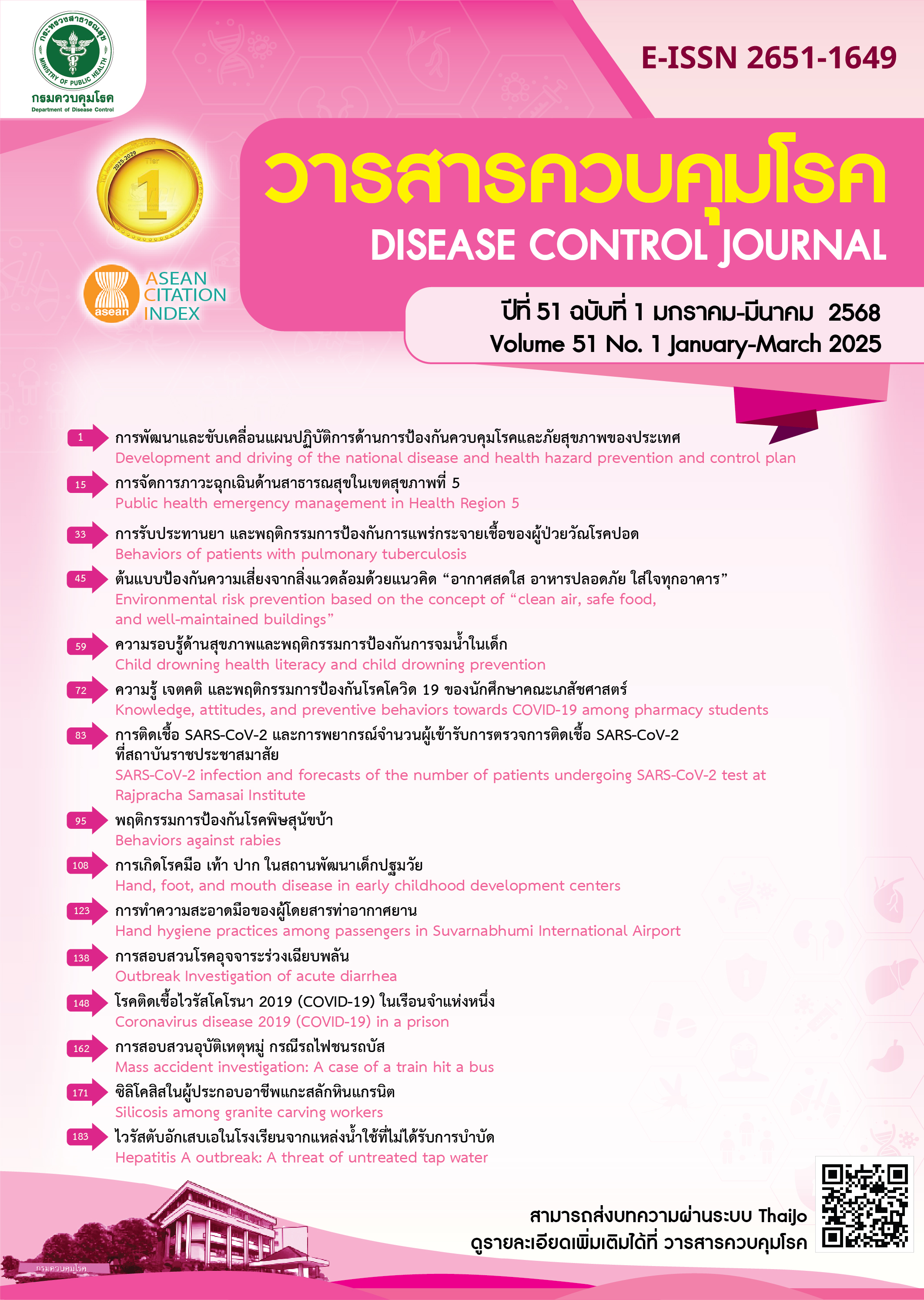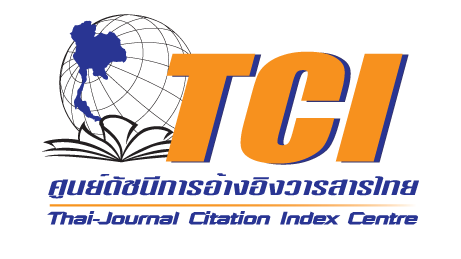Health perception and hand hygiene practices among Thai passengers in Suvarnabhumi International Airport
DOI:
https://doi.org/10.14456/dcj.2025.10Keywords:
health perception, hand hygiene, passengerAbstract
Promoting hand hygiene in public places is extremely challenging, especially in airports, which are travel hubs where travelers worldwide come together. This creates an environment conducive to the spread of various infectious diseases through numerous shared surfaces. This exploratory research aims to assess health perceptions and hand hygiene practices and identify the relationship between perceptions and hand hygiene practices of Thai passengers at Suvarnabhumi International Airport. The sample group consists of 72 Thai passengers, both inbound and outbound. Data was collected using a questionnaire developed by applying the concept of the Health Belief Model. The data were analyzed using descriptive statistics and probit regression analysis. The study results showed that the perception of hand hygiene benefits was at a 'very high' level. The perception of the risk of contracting diseases and the severity of diseases are at a 'high' level. The perception of hand hygiene barriers is at a relatively low level and does not hinder hand hygiene performance. The perception of health motivation is at a 'high' level. Thai passengers reported “always” and “frequently” performed hand hygiene in 6 situations, including after using the toilet (94.5%), before eating (79.1%), after leaving the airplane (57.0%), after passing through the security check (51.4%), before boarding (45.8%), and before passing through the security check (45.8%). Water with soap and Alcohol hand rub are mostly used to perform hand hygiene. The duration for each hand hygiene performance is around 5-15 seconds. The perception of the risk of contracting diseases, the perception of the severity of diseases, the perception of hand hygiene benefits, the perception of hand hygiene barriers, and the perception of health motivation were significantly associated with hand hygiene performed before passing through the security check (p-value=0.02) and after passing through the security check (p-value=0.04). The low perception of hand hygiene barriers was associated with the relatively high frequency of hand hygiene performed before and after passing through the security check. However, significant association between health perception and motivation and hand hygiene performed before eating, before boarding, before leaving the airplane, and after using the toilet were not found (0.09<p-value<0.87). The findings of this research can be used as guidance for improving facilities and environmental arrangements and providing alcohol gel stations for hand hygiene purposes that effectively reach travelers. This would contribute to promoting good health behaviors, which would benefit the target population by helping reduce the incidence of the spread of pathogens through contact with various environmental surfaces within the airport, both in the present and in the future.
Downloads
References
MacLeod C, Braun L, Caruso BA, Chase C, Chidziwisano K, Chipungu J, et al. Recommendations for hand hygiene in community settings: a scoping review of current international guidelines. BMJ Open. 2023;13(6):e068887.
Mwesigye P, Sekhon B, Punni A, McDonnell G, Salman O, Hyde S, et al. Knowledge, attitudes, and self-reported practices (KAP) towards hand hygiene in medical students versus the public. Ir J Med Sci. 2022;191(6):2797-802.
Nicolaides C, Avraam D, Cueto‐Felgueroso L, Gonzulez MC, Juanes R. Hand‐Hygiene Mitigation Strategies Against Global Disease Spreading through the Air Transportation Network. Risk Analysis. 2019;40(4):723-40.
Ikonen N, Savolainen-Kopra C, Enstone JE, Kulmala I, Pasanen P, Salmela A, et al. Deposition of respiratory virus pathogens on frequently touched surfaces at airports. BMC Infectious Diseases. 2018;18(1):437.
Ezezika OC, Heng J, Fatima K, Mohamed A, Barrett K. What are the barriers and facilitators to community handwashing with water and soap? A systematic review. What are the barriers and facilitators to community handwashing with water and soap? A systematic review. 2023;3(4)e0001720-0.
Airports of Thailand Public Company Limited. Airport Traffic Report 2022 [Internet]. [cited 2023 Sep 10] Available from: https://www.airportthai.co.th/wp-content/uploads/2023/04/ANNUAL-REPORT-2022.pdf
Hfocus. Thai people have better hand hygiene after touching dirty things [Internet]. [cited 2023 Sep 10]. Available from: https://www.hfocus.org/content/2021/10/23374 (in Thai)
Department of Health (TH). School children below 15 years old tend to have lower handwashing [Internet]. Anamaimedia. 2022 [cited 2025 Jan 21]. Available from: https://multimedia.anamai.moph.go.th/news/230565/ (in Thai)
Siangphro K. Theories/Techniques in Healthy behavioral development and application in public health. Bangkok: CUPress; 2021. (in Thai)
World Health Organization. WHO guidelines on hand hygiene in health care : First global patient safety challenge clean care is safer care. Geneva: World Health Organization; 2009.
Khateeb N. Use of the Health Belief Model to Assess Hand Hygiene Knowledge, Perceptions, and Practices of Saudi Students Studying in the U.S. [Internet]. Clemson OPEN. 2025 [cited 2023 Sep 10]. Available from: https://open.clemson.edu/all_theses/1286
Budtrachan B. Relationship between benefits barriers, and health behaviors toward preventing the spread of coronavirus in people elderly Lankrabue district Kamphaengphet province. Primary Health Care Journal (Northeastern Edition). 2023;38(1):66-78. (in Thai)
Carpenter CJ. A meta-analysis of the effectiveness of health belief model variables in predicting behavior. Health Commun. 2010;25(8):661-9.
Gardner B, Arden MA, Brown D, Eves FF, Green J, Hamilton K, et al. Developing habit-based health behaviour change interventions: twenty-one questions to guide future research. Psychol Health. 2023;38(4):518-40.
Downloads
Published
How to Cite
Issue
Section
License
Copyright (c) 2025 Disease Control Journal

This work is licensed under a Creative Commons Attribution-NonCommercial-NoDerivatives 4.0 International License.
Articles published in the Disease Control Journal are considered as academic work, research or analysis of the personal opinion of the authors, not the opinion of the Thailand Department of Disease Control or editorial team. The authors must be responsible for their articles.






